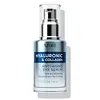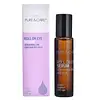What's inside
What's inside
 Key Ingredients
Key Ingredients

 Benefits
Benefits

 Concerns
Concerns

 Ingredients Side-by-side
Ingredients Side-by-side

Water
Skin ConditioningGlycerin
HumectantDipropylene Glycol
HumectantBetaine
HumectantSodium Hyaluronate
HumectantRetinol
Skin ConditioningAloe Barbadensis Leaf Extract
EmollientBeta-Glucan
Skin ConditioningMacadamia Ternifolia Seed Oil
EmollientPanthenol
Skin ConditioningNiacinamide
SmoothingButylene Glycol
HumectantCaprylic/Capric Triglyceride
MaskingHydrogenated Lecithin
EmulsifyingCholesterol
EmollientBrassica Campestris Sterols
EmollientCeteth-3
EmulsifyingCeteth-5
EmulsifyingTocopheryl Acetate
AntioxidantPotassium Cetyl Phosphate
EmulsifyingPolysorbate 20
EmulsifyingAlcohol
AntimicrobialHydroxyethylcellulose
Emulsion StabilisingArginine
MaskingCarbomer
Emulsion StabilisingPEG-60 Hydrogenated Castor Oil
EmulsifyingGlyceryl Acrylate/Acrylic Acid Copolymer
Humectant1,2-Hexanediol
Skin ConditioningEthylhexylglycerin
Skin ConditioningPhenoxyethanol
PreservativeParfum
MaskingWater, Glycerin, Dipropylene Glycol, Betaine, Sodium Hyaluronate, Retinol, Aloe Barbadensis Leaf Extract, Beta-Glucan, Macadamia Ternifolia Seed Oil, Panthenol, Niacinamide, Butylene Glycol, Caprylic/Capric Triglyceride, Hydrogenated Lecithin, Cholesterol, Brassica Campestris Sterols, Ceteth-3, Ceteth-5, Tocopheryl Acetate, Potassium Cetyl Phosphate, Polysorbate 20, Alcohol, Hydroxyethylcellulose, Arginine, Carbomer, PEG-60 Hydrogenated Castor Oil, Glyceryl Acrylate/Acrylic Acid Copolymer, 1,2-Hexanediol, Ethylhexylglycerin, Phenoxyethanol, Parfum
Water
Skin ConditioningPropanediol
SolventSnail Secretion Filtrate
Skin ConditioningGlycerin
HumectantCorn Gluten Amino Acids
Skin ConditioningButylene Glycol
HumectantAloe Barbadensis Leaf Extract
EmollientSodium Polyglutamate
HumectantOligopeptide-1
Skin ConditioningOligopeptide-2
Skin ConditioningOligopeptide-5
Skin ConditioningSilk Extract
Skin ConditioningCollagen
MoisturisingHyaluronic Acid
HumectantAvena Sativa Kernel Extract
AbrasiveYeast Ferment Extract
Skin ConditioningPolygonum Cuspidatum Root Extract
AntioxidantCamellia Sinensis Leaf Extract
AntimicrobialChamomilla Recutita Flower Extract
MaskingGlycyrrhiza Glabra Root Extract
BleachingRosmarinus Officinalis Leaf Extract
AntimicrobialScutellaria Baicalensis Root Extract
AstringentPortulaca Oleracea Extract
Skin ConditioningCentella Asiatica Extract
CleansingSodium Hyaluronate
HumectantBeta-Glucan
Skin ConditioningPropylene Glycol
HumectantHexylene Glycol
EmulsifyingXanthan Gum
Emulsifying1,2-Hexanediol
Skin ConditioningHydroxyacetophenone
AntioxidantEthylhexylglycerin
Skin ConditioningPhenoxyethanol
PreservativePotassium Sorbate
PreservativeSodium Hydroxide
BufferingWater, Propanediol, Snail Secretion Filtrate, Glycerin, Corn Gluten Amino Acids, Butylene Glycol, Aloe Barbadensis Leaf Extract, Sodium Polyglutamate, Oligopeptide-1, Oligopeptide-2, Oligopeptide-5, Silk Extract, Collagen, Hyaluronic Acid, Avena Sativa Kernel Extract, Yeast Ferment Extract, Polygonum Cuspidatum Root Extract, Camellia Sinensis Leaf Extract, Chamomilla Recutita Flower Extract, Glycyrrhiza Glabra Root Extract, Rosmarinus Officinalis Leaf Extract, Scutellaria Baicalensis Root Extract, Portulaca Oleracea Extract, Centella Asiatica Extract, Sodium Hyaluronate, Beta-Glucan, Propylene Glycol, Hexylene Glycol, Xanthan Gum, 1,2-Hexanediol, Hydroxyacetophenone, Ethylhexylglycerin, Phenoxyethanol, Potassium Sorbate, Sodium Hydroxide
Ingredients Explained
These ingredients are found in both products.
Ingredients higher up in an ingredient list are typically present in a larger amount.
1,2-Hexanediol is a synthetic liquid and another multi-functional powerhouse.
It is a:
- Humectant, drawing moisture into the skin
- Emollient, helping to soften skin
- Solvent, dispersing and stabilizing formulas
- Preservative booster, enhancing the antimicrobial activity of other preservatives
Aloe Barbadensis Leaf Extract is an extract of the leaves of the aloe, Aloe barbadensis, Liliaceae.
Aloe is one of the most well-known natural soothing ingredients, and for good reason. It’s full of water and has a cooling, calming effect on the skin, especially when it’s sunburned, itchy, or irritated. Aloe also helps your skin stay hydrated and smooth by mimicking what healthy skin naturally produces. On top of that, it contains vitamins and nutrients that support skin recovery.
It doesn’t protect you from the sun, but it can help your skin bounce back after too much time in it.
Let’s get into the details:
Aloe contains antioxidant Vitamins A, C, and E, which help fight off free radicals (unstable molecules from things like pollution that can damage your skin).
It’s also rich in polysaccharides, which are natural sugars that help hydrate the skin by acting like the skin’s own moisturizing agents. These, along with other sugars like monosaccharides, help form a protective barrier that locks in moisture.
Aloe works as both a humectant and an emollient. That means it draws water into the skin (humectant) and helps trap it there (emollient), making it an effective natural moisturizer.
You’ll also find a mix of other skin-supporting ingredients in aloe, including folic acid, choline, calcium, amino acids, fatty acids, and even Vitamin B12.
Out of the 420+ species of aloe, Aloe barbadensis is the most widely used in skincare products thanks to its gentle yet effective properties.
There are over 420 species of aloe but Aloe Barbadensis is the most commonly used for topical products.
Learn more about Aloe Barbadensis Leaf ExtractBeta-Glucan is a polysaccharide. It can be derived from the cell walls of seaweed, oats, yeast, and fungi. It hydrates the skin and helps boost your skin's natural barrier.
As an antioxidant, beta-glucan helps fight free-radicals. Free-radicals are molecules that may damage your skin cells, such as pollution.
Studies show this ingredient may be an effective wrinkle reducer as it can deeply penetrate into skin. It has also been show to help with wound healing.
Learn more about Beta-GlucanButylene Glycol (or BG) is used within cosmetic products for a few different reasons:
Overall, Butylene Glycol is a safe and well-rounded ingredient that works well with other ingredients.
Though this ingredient works well with most skin types, some people with sensitive skin may experience a reaction such as allergic rashes, closed comedones, or itchiness.
Learn more about Butylene GlycolEthylhexylglycerin (we can't pronounce this either) is commonly used as a preservative and skin softener. It is derived from glyceryl.
You might see Ethylhexylglycerin often paired with other preservatives such as phenoxyethanol. Ethylhexylglycerin has been found to increase the effectiveness of these other preservatives.
Glycerin is already naturally found in your skin. It helps moisturize and protect your skin.
A study from 2016 found glycerin to be more effective as a humectant than AHAs and hyaluronic acid.
As a humectant, it helps the skin stay hydrated by pulling moisture to your skin. The low molecular weight of glycerin allows it to pull moisture into the deeper layers of your skin.
Hydrated skin improves your skin barrier; Your skin barrier helps protect against irritants and bacteria.
Glycerin has also been found to have antimicrobial and antiviral properties. Due to these properties, glycerin is often used in wound and burn treatments.
In cosmetics, glycerin is usually derived from plants such as soybean or palm. However, it can also be sourced from animals, such as tallow or animal fat.
This ingredient is organic, colorless, odorless, and non-toxic.
Glycerin is the name for this ingredient in American English. British English uses Glycerol/Glycerine.
Learn more about GlycerinPhenoxyethanol is a preservative that has germicide, antimicrobial, and aromatic properties. Studies show that phenoxyethanol can prevent microbial growth. By itself, it has a scent that is similar to that of a rose.
It's often used in formulations along with Caprylyl Glycol to preserve the shelf life of products.
Sodium Hyaluronate is hyaluronic acid's salt form. It is commonly derived from the sodium salt of hyaluronic acid.
Like hyaluronic acid, it is great at holding water and acts as a humectant. This makes it a great skin hydrating ingredient.
Sodium Hyaluronate is naturally occurring in our bodies and is mostly found in eye fluid and joints.
These are some other common types of Hyaluronic Acid:
Learn more about Sodium HyaluronateWater. It's the most common cosmetic ingredient of all. You'll usually see it at the top of ingredient lists, meaning that it makes up the largest part of the product.
So why is it so popular? Water most often acts as a solvent - this means that it helps dissolve other ingredients into the formulation.
You'll also recognize water as that liquid we all need to stay alive. If you see this, drink a glass of water. Stay hydrated!
Learn more about Water